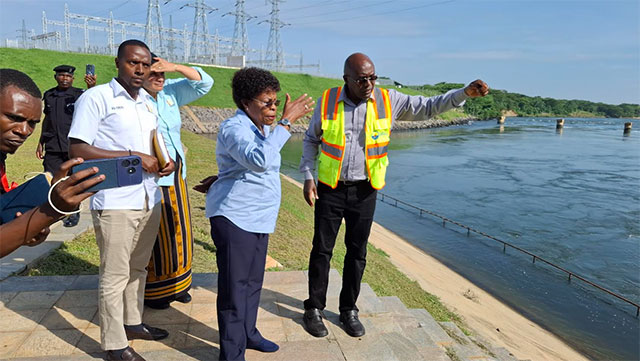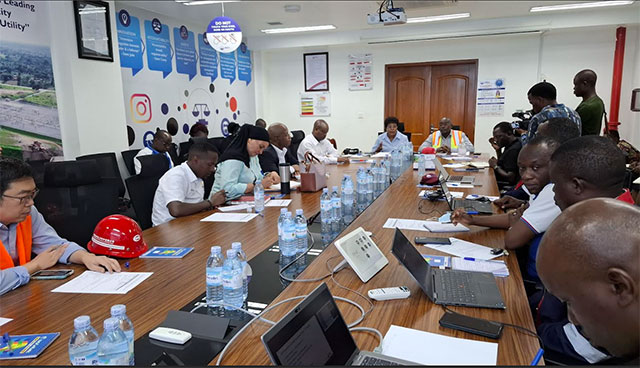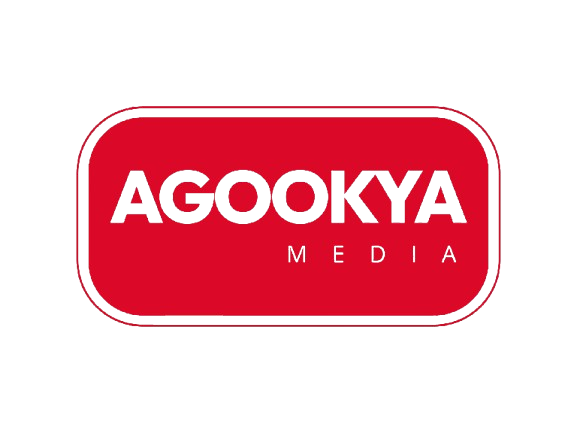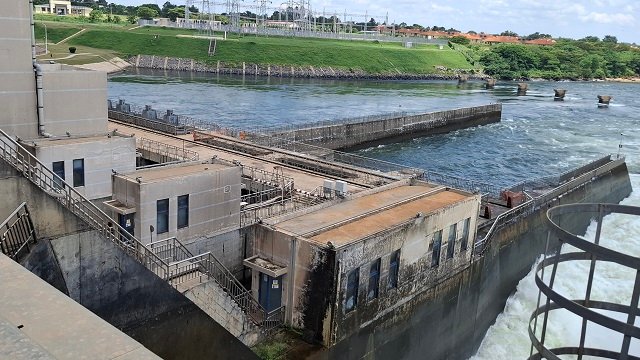For many hydroelectricity producers around the world, rainfall is a welcome blessing that ensures a steady power supply. But for Harrison Mutikanga, the CEO of the Uganda Electricity Generation Company Ltd (UEGCL), heavy rains around the Lake Victoria basin cause him sleepless nights as he worries about the safety of the Isimba Hydropower Plant—one of Uganda’s newest power stations on the River Nile.
“When you have a spillway that may not be able to handle its flood design capacity, and heavy rains keep coming, it’s impossible not to worry—especially now that the spillway has defects that have compromised its functionality,” Mutikanga recently explained to Beti Kamya, the Inspector General of Government, during her inspection of the 183MW Isimba Hydropower Plant, which President Yoweri Museveni commissioned just six years ago.
“Whenever it rains, more water has to be released through the spillway. But if there’s significant leakage beneath the foundation of the concrete basin, it can lead to what we call hydraulic jacking—where the concrete slab is lifted. If that happens, it could trigger backward erosion that reaches the dam’s foundation, potentially resulting in dam failure.”
Mutikanga said a dam failure would be catastrophic to the downstream communities, because of the activities that are happening downstream including farming and settlement. “Once the dam collapses, you are releasing this whole volume of water; millions of cubic metres of water downstream. You have so many people on the downstream side. So, you can lose people, you can cause a lot of damage to the environment. That worries us a lot,” he added.
Isimba HPP construction
Thanks to significant funding from the Chinese government through the Exim Bank which loaned 85% of US$567.7 million in investment, the hydropower project was constructed for 47 straight months by China International Water and Electricity Corporation (CWE). The Uganda Electricity Generation Company Limited (UEGCL) monitored the construction progress of the plant to ensure that all works were of standard and implemented as per the timelines.
On 21 March 2019, President Yoweri Museveni commissioned the power project. However, although electricity generation has since continued uninterrupted, experts and engineers have recently found defects on sections of the dam and officials at UEGCL have stressed the need for urgent and lasting repairs to secure the dam’s future.

“Isimba Hydropower Plant is generating electricity, all the four units are working very well, the electromechanical equipment is good, but the biggest concern we have on Isimba is dam safety,” Mutikanga told the IGG on April 25.
Mutikanga says when his team did an underwater inspection in August 2022; they found massive concrete erosion for the spillway basin. He says the contractor did emergency repairs underwater but this was not effective as subsequent inspections done in September, and also December, last year, by the contractor, still found that the dam spillway concrete has continued to be eroded. “There are also cracks in the joint seals, and that poses a very serious problem,” he said.
“We have been telling the contractor that he needs to do everything possible to make sure that he carries out effective repairs, and maybe look at a long-term solution, which might probably be building a new spillway, because there is also an issue of the capacity of the spillway,” Mutikanga added.
Mutikanga says despite the issues of the spillway, the plant is performing very well from a commercial perspective. “We are generating very good revenues from the plant. We are able to service our debts with Exim Bank of China,” Mutikanga said. “Commercially, the plant is doing very well. If we can have these technical defects addressed, I think we have a very good plant in the scene.”
Spillway defects
The spillway has had a number of challenges, starting from June 2022 when UEGCL conducted a diving inspection to inspect the performance of the spillway, explained Eng. Chad Akita, the Project Manager at Isimba Hydropower Plant.
Eng. Akita said when the diving inspection was conducted; the team of divers noted a number of defects. This included damage to the buffer blocks and damage to the joints. Another inspection conducted in 2024 by the contractor confirmed that these defects still exist, and that they are actually increasing from the evidence collected.
“These include issues like gaps within the slab. We have concrete erosion within the bottom slab. The main concern here is that the reinforcement continues to be exposed and will be subject to corrosion. So there is need for urgent repair to prevent this further deterioration of the concrete,” Eng. Akita said.
Chinese contractors mute
Although representatives of the contractors attended the closed-door meeting, they did not speak to the press. However, Mutikanga, the UEGCL CEO, said the contractors are not disputing that there is a problem at Isimba.
“Like I told you, they did inspections in December last year, and they issued a report. And their recommendation was that we need to act promptly to address concrete erosion, deficiencies, and also the cracks that had developed in the ceiling joints,” he said. “They also acknowledge that there is a problem, but the challenge is they are too slow to address the problem. I think they are having an issue with the methodology of how to address the problem.”
Defects liability
Beti Kamya, the IGG told journalists who tagged alongside her team that she had visited Isimba Hydropower Plant to “specifically check out what is happening.”
She said the Inspectorate of Government had received a complaint about the quality of work at the Isimba hydropower plant. “When we received several complaints about the management, the quality of this plant, we decided to take interest and get involved and launch an investigation,” she said.
After several hours of inspection which involved visiting the central control room of the plant, the terrace coolers and the powerhouse and embankment dam, the IGG together with senior representatives from UEGCL, the Ministry of Energy and Mineral Development, the contractors, and officials from the Office of the Attorney General, got into a closed-door meeting in order for the Inspectorate of Government “to listen to all the issues.”

“We decided to come to the site and have an inspection so that we relate the issues that have been claimed in the petitions, the issues that came out in the meetings and the issues on the ground. Today was basically a fact-finding mission at site and we’ve had a very productive meeting,” Kamya said.
“I can see that there are some quality issues, especially with the structure. It looks like a very old structure instead of a structure that is about five years old. It looks like a structure of the fifties and I think there are serious quality issues there.”
“The chalk is peeling outside, there are cracks in the building. So, there are visible quality issues even to a layperson like myself,” she said.
“We’ve also seen some of the more technical information but we have agreed that now, for us, the inspectors of the government, we have to go back to our office and internalize everything we have heard and seen, evaluate, do further investigations, further interactions and then in about three weeks’ time, we shall come out with a position on how we want to move.”
Still Kamya told The Independent that there appears to be a big problem between the contractor and the employer not agreeing on what the problem is as well as the the extent of the problem.
“We shall evaluate the information that we have received and come up with our own report. But, for now, the petitions were against the quality of work.” “The quality of work is mainly the contractor’s issue,” she said. “But maybe the problem was also at the time of supervision. Who slept on the job in supervising the contractor? That’s where maybe we shall find where the problem is.”

However, Mutikanga told The Independent that “It’s not unusual for mega projects like Isimba to have defects.” “That’s why the contractor allows you a defects liability period or a defects notification period, so that when these defects are revealed, then the contractor should be able to fix them within the defects liability period,” he said.
“The challenge we have at Isimba is that the two-year defects liability period expired, the defects were still not remedied. We added another two years; the defects were still not corrected. So, that is where the problem is. But it is not unusual that you get defects on mega projects like the one we have here.”
Still, Herbert Kato, the Senior Energy Officer in the Ministry of Energy and Mineral Development noted that although, in terms of operation, the country is generating power, in terms of longevity, that is where the ministry technocrats have concern.
Kato said when dam structures are being designed, they are meant to be able to save themselves during emergencies and one critical aspect is that of the spillway. “So, where it stands today, if such an occurrence happened, we are not sure it can do that (save itself from a flood incident).”
Disagreement over critical issues
Yet, it appears there are disagreements between the two parties on how to go about the remedial works. A case in point is how the two parties perceive the magnitude of damage and dam safety risks of spillway. Whereas the EPC Contractor’s position is that the spillway structure meets the employers’ requirements and specifications, and the structure is safe and stable, the UEGCL says the spillway structure and its components are not safe and are unstable based on evidence of performance and observations of concrete damages and erosion from diving underwater inspections.
“The spillway structure vibrates violently beyond 40% gate opening, which has led to damage of handrails and continuous splashing of water on the hydraulic pump rooms,” a brief to the IGG seen by The Independent reads in part. Indeed, the contractor’s inspection report of December 2024, acknowledged that urgent repairs are required to prevent further deterioration. “The contractor is inconsistent with their presentation of the dam condition,” says the brief.
According to a repair roadmap, it has been suggested that the repairs be done in three phases. During the first phase, repair works on the lower spillway were completed in March 2023 with underwater emergency repairs of the damaged concrete of Spillway1-1, Spillway1-2, and Spillway 1-3 being undertaken by the contractor from January 2023 to March 2023. In this phase, all cavities in the slabs and gate slots were temporarily repaired.
During the second phase, works on the lower spillway commenced but was suspended on Feb.21, 2024, due to increased water discharge in the River Nile. Meanwhile, in the third phase, the works that entail the long-term spillway rehabilitation works are yet to begin.
Apparently, the contractor insists the emergency repairs to the spillway need to be performed underwater, while UEGCL and the Ministry of Energy and Mineral Development should provide access control through regulation of upstream water level in coordination with the Ministry of Water and the Directorate of Water Resources Management.
But UEGCL says with the high river flows and unpredictable river discharge from Lake Victoria, upstream level water regulation for safe access to the spillway is not practicable for long durations of time, when underwater diving will be required to facilitate the proposed underwater repairs.

UEGCL says only short windows of access control (less than two hours) have been possible to allow the completed underwater diving inspections. UEGCL adds that it is not possible to achieve effective full-scale comprehensive inspection of the spillway stilling basin downstream area, end sill and plum concrete structure and riprap stone layer, to understand the extent of damage.
For that, UEGCL says a comprehensive inspection is critical to aid preparations of effective defect treatment and repair procedures. The electricity generation agency says without a clear understanding of conditions downstream, there is a danger that important repair works might be poorly built and could fail in the near future.
Meanwhile, the contractor has also cautioned that using a dry inspection and repair method (one that doesn’t involve water or might not fully simulate real operating conditions) poses the risk of causing uplift (lifting or displacement of materials) in the structure. This could result in further damage to the spillway stilling basin, and if repairs or inspections lead to problems, it could cause the plant to shut down temporarily, leading to a loss of revenue.
But UEGCL counters this counsel saying the contractor has not explored all options for achieving dry inspection and dry repair works within the spillway. The contractor’s latest proposal considered uncontrolled water diversion in addition to using upstream and downstream cofferdams. This proposal can be optimized by introducing controlled water diversion within the diversion channel, which will allow the retention of water in the reservoir for continued power generation, without plant shutdown.
It’s all about moneyIt also appears spending money to repair the defects is the point of departure. For example, when it comes to costing of the cooling water system modification, the contractor do not want the cost capped at US$1 million. Instead, the contractor submitted a commercial proposal of US$5,155,044 for implementation of the modified cooling water system.
However, UEGCL argues that it was agreed at a Statehouse meeting of 22 October 2022 that the contractor shall modify/replace the existing cooling water system to match its original specifications in the employer’s requirements.
UEGCL also points to the contract between the two parties which stipulates that the government (the employer) will bear the cost of this change, which is not expected to exceed US$1 million.
The current cooling water system was designed and installed underwater which requires total plant shutdown to allow accessing them for maintenance activities. According to the contract signed between UEGCL and the Chinese firm, the design of the dam, including the civil, and structural features shall provide a 100-year service life, while the electrical and mechanical systems shall be designed for a service life of at least 40 years.
“The design service life of a structure or equipment is the period for which it is to be used for its intended purpose. Regular routine maintenance is anticipated but structural reliability and operational integrity shall be maintained.”
“No structural element shall require refurbishment or replacement within the first 40 years. The facilities are designed such that they can be operated safely, reliably and economically and are fit for purpose. The design of the facilities are in such a way that they can be readily maintained, are secure, and are capable of continuous operation with minimum attention and maintenance.”
Particularly, clause 3.1, states that: “The contractor shall design, manufacture, install and complete the facilities in accordance with the contract.” The contract also stipulates that the “Contractor warrants that the facilities or any part thereof shall be free from defects.”


